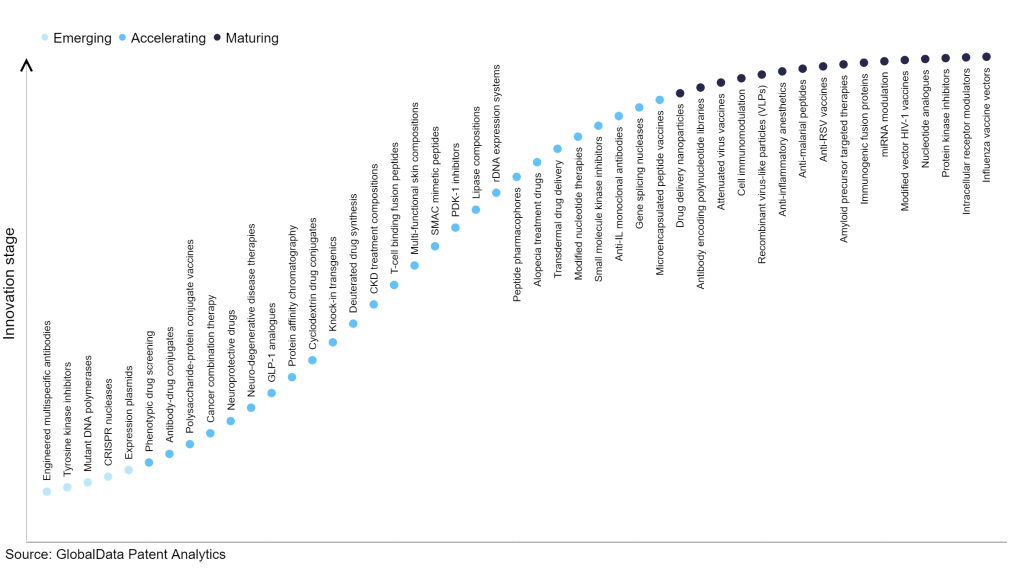The pharmaceutical industry continues to be a hotbed of patent innovation. Activity is driven by the evolution of new treatment paradigms and the gravity of unmet need, as well as the growing importance of technologies such as pharmacogenomics, digital therapeutics, and artificial intelligence. In the last three years alone, there have been over 787,000 patents filed and granted in the pharmaceutical industry, according to GlobalData’s report on Innovation in pharma: CRISPR nucleases. Buy the report here.
However, not all innovations are equal and nor do they follow a constant upward trend. Instead, their evolution takes the form of an S-shaped curve that reflects their typical lifecycle from early emergence to accelerating adoption, before finally stabilizing and reaching maturity.
See Also:
Identifying where a particular innovation is on this journey, especially those that are in the emerging and accelerating stages, is essential for understanding their current level of adoption and the likely future trajectory and impact they will have.
80+ innovations will shape the pharmaceutical industry
According to GlobalData’s Technology Foresights, which plots the S-curve for the pharmaceutical industry using innovation intensity models built on over 668,000 patents, there are 80+ innovation areas that will shape the future of the industry.
Within the emerging innovation stage, engineered multispecific antibodies, tyrosine kinase inhibitors, and mutant DNA polymerases are disruptive technologies that are in the early stages of application and should be tracked closely. Phenotypic drug screening, antibody-drug conjugates, and polysaccharide-protein conjugate vaccines are some of the accelerating innovation areas, where adoption has been steadily increasing. Among maturing innovation areas are drug delivery nanoparticles and antibody encoding polynucleotide libraries, which are now well established in the industry.
Innovation S-curve for the pharmaceutical industry

CRISPR nuclease is a key innovation area in pharmaceutical industry
CRISPR, which refers to clustered regularly interspaced short palindromic repeats, are bacteriophage-derived DNA sequences that had previously infected the prokaryote and are found in the genomes of bacteria and archaea. Cas, also called CRISPR associated proteins, are a family of nucleases such as Cas9, Cas12a, Cas12b, and CasX that process these sequences. The eukaryotic genome can be cut at any desired position by introducing plasmids containing Cas genes and specifically constructed CRISPRs into eukaryotic cells. CRISPR nucleases serve as an important genome editing tool.
GlobalData’s analysis also uncovers the companies at the forefront of each innovation area and assesses the potential reach and impact of their patenting activity across different applications and geographies. According to GlobalData, there are 460+ companies, spanning technology vendors, established pharmaceutical companies, and up-and-coming start-ups engaged in the development and application of CRISPR nucleases.
Key players in CRISPR nucleases – a disruptive innovation in the pharmaceutical industry
‘Application diversity’ measures the number of applications identified for each patent. It broadly splits companies into either ‘niche’ or ‘diversified’ innovators.
‘Geographic reach’ refers to the number of countries each patent is registered in. It reflects the breadth of geographic application intended, ranging from ‘global’ to ‘local’.
Patent volumes related to CRISPR nucleases
| Company | Total patents (2010 - 2022) | Premium intelligence on the world's largest companies |
| Hyundai Mobis | 6 | Unlock Company Profile |
| Bridgestone | 1 | Unlock Company Profile |
| Zhejiang Asia-Pacific Mechanical & Electronic | 2 | Unlock Company Profile |
| Daimler AG (USA) | 1 | Unlock Company Profile |
| NTT | 15 | Unlock Company Profile |
| Mercedes-Benz Group | 6 | Unlock Company Profile |
| Toyota Motor | 14 | Unlock Company Profile |
| Schaeffler | 10 | Unlock Company Profile |
| BYD | 2 | Unlock Company Profile |
| Hyundai Motor | 4 | Unlock Company Profile |
| Nissan Motor | 16 | Unlock Company Profile |
| NTN | 9 | Unlock Company Profile |
| Honda Motor | 7 | Unlock Company Profile |
| Komatsu | 8 | Unlock Company Profile |
| Microelectronica MASER | 13 | Unlock Company Profile |
| Porsche Automobil | 5 | Unlock Company Profile |
| Kia | 5 | Unlock Company Profile |
| Ford Motor | 1 | Unlock Company Profile |
| Stellantis | 3 | Unlock Company Profile |
| Applied Electric Vehicles | 2 | Unlock Company Profile |
| Zeppelin-Stiftung | 2 | Unlock Company Profile |
| REE Automotive | 3 | Unlock Company Profile |
Source: GlobalData Patent Analytics
Editas Medicine is one of the most important players concerning innovation surrounding CRISPR nucleases. The company is largely involved in genome editing using CRISPR/Cas9 and CRISPR/Cas12a systems. Developing both in vivo and ex vivo gene editing medicines, Editas Medicine is primarily involved in the hematology and oncology therapy areas.
In terms of application diversity, Puretech Health is the top company followed by Biocytogen Pharmaceuticals and KSQ Therapeutics. By means of geographic reach, Snipr Technologies holds the top position. E.Merck and Cibus US are in the second and third positions, respectively.
To further understand the key themes and technologies disrupting the pharmaceutical industry, access GlobalData’s latest thematic research report on Pharmaceutical.
Premium Insights
From

The gold standard of business intelligence.
Blending expert knowledge with cutting-edge technology, GlobalData’s unrivalled proprietary data will enable you to decode what’s happening in your market. You can make better informed decisions and gain a future-proof advantage over your competitors.




